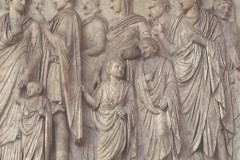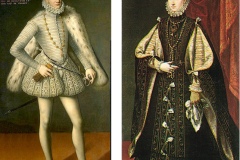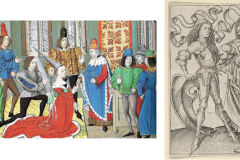“The language of clothes,” the now-late art historian Anne Hollander wrote, “is essentially wordless—that is what it was created to be, so that it can operate freely below the level of conscious thought and utterance.” The language is wordless and yet she found the words to convey the effect. Hollander, who died recently at the age of eighty-three, came up with the words to describe a millennium of Western dress and visual art—some of the most visceral and least parse-able of human creations.
Clothes, especially, are so laden with social and personal associations that it’s sometimes difficult to know what we feel, let alone think, about a certain look. This layered complexity, too, was part of Hollander’s extraordinary critical reach. “Fashion,” she wrote in her most well known book, Sex and Suits, “is constantly complicated by the rhetoric that surrounds it, the emotionally or commercially motivated remarks that can cast a transforming spell on its formal elements. As a consequence, fashions often look no more ridiculous than interpretations of them do.”
But she went right after direct perception in her articles and several books, not just writing literal descriptions of clothes. And she explicitly did not allow social or political factors to overshadow the sheer intuitive power of aesthetics. “In speaking of dress,” she wrote, “I am always concerned either with line and form or with sex and poetry, not with money and power.”
John Updike seemed to revel in her prowess with language in his review of Sex and Suits, praising her “delicacy of perception”. This description of women’s dress in the late Middle Ages struck him as “unexpectedly thrilling”:
Her pelvis and legs were always a mystery, her feet a sometime thing, and her bosom a constantly changing theatrical presentation of some kind. Needless to say, her exposed hands were always dramatic costume elements, exciting bare episodes in a sea of fabric.
This ability to give a sense of what something felt like to the eyes that saw them for the first time allowed her to write vividly about clothes that are inert set-pieces to us now. The appeal of a top hat, to the generations of people who didn’t laugh at top hats, had something to do with height, at their ability to turn a man into “a tower, a column, a reassuring and noble monument”. Showing a picture of a moody Marlon Brando from A Streetcar Named Desire, she points out that “Brando shows an awareness that a tee-shirt is male underwear, and that its display is as sexy as his expression or his muscles”. Arguing that rigid corsets and tight stays were a broadly welcome part of everyday clothing for both men and women for centuries, she wrote that they gave “the sense of completeness that acceptable clothing always gives, which is its true comfort.” (A great number of us would still gladly accept a little pinch in the waist in exchange for the apparent loss of twenty pounds.)
For her, making sense of contemporary fashion had less to do with inspecting individual articles of clothing than it did with realizing what a hodgepodge of historical styles we’re now throwing together under the influence of the rapid set-changes of cinema and magazine images.
A post-modern person, now one of either sex, has further learned that not only may disparate wardrobes cohabit in one person’s closet, as if on backstage costume racks, but they may now be combined. … [I]n the new world of music video and free-wheeling, overlapping, unrooted camera imagery, old denim and fresh spangles or pale chiffon and black combat boots are worn not just in quick succession but together.
She was even able to give some sexualization to contemporary baggy clothes:
Tee-shirts began skin-tight; but it’s clear that they really make the wearer even more naked if they’re loose and keep all specific bumps and hollows from intruding on the eye […] just an ambling bare body […]
Hollander often used the word “articulation” to describe the clear outlines of men’s limbs throughout the history of Western fashion—first in body armor and, finally, in the suit. (This was in contrast to the flowing, obscuring robes and tunics men and women had always worn previously.) It was her own remarkable articulation of our senses—pointing out just why we felt what we felt, and making us feel what we were born centuries too late to have felt—that left us better able to talk about the visual world that has no language.
Illustrations from Sex and Suits
See the male suit emerge from the uniform robes of antiquity, and the corresponding interplay with female clothing.




![“Romantic suited man, in a suitable setting. […] The English sage climbs among the wild rocks and torrents, his suit forming an intelligent visual abstraction of the chaotic forms in nature, out of which he makes order as he walks.” –Anne Hollander, Sex and Suits (Image via Wikimedia) “Romantic suited man, in a suitable setting. […] The English sage climbs among the wild rocks and torrents, his suit forming an intelligent visual abstraction of the chaotic forms in nature, out of which he makes order as he walks.” –Anne Hollander, Sex and Suits (Image via Wikimedia)](https://meaningfulaudacity.com/wp-content/gallery/anne-hollander-gallery/thumbs/thumbs_Millais_Ruskin-e1406490468108-893x1024.jpg)
![“Realistic suited man. […] The American president visits the battlefield in a suit that turns him into a tower, a column, a reassuring and noble monument under the framing tend.” –Anne Hollander, Sex and Suits (Image via Wikimedia) “Realistic suited man. […] The American president visits the battlefield in a suit that turns him into a tower, a column, a reassuring and noble monument under the framing tend.” –Anne Hollander, Sex and Suits (Image via Wikimedia)](https://meaningfulaudacity.com/wp-content/gallery/anne-hollander-gallery/thumbs/thumbs_Lincoln-McClernand-Pinkerton-e1406480925911.jpg)
